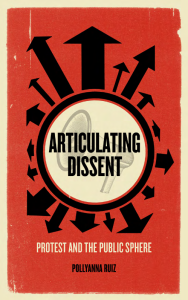The mainstream’s current lack of familiarity with the organisational strategies of coalition movements has resulted in a tendency to perceive different types of order as a threatening, potentially violent, lack of order. Partly as a result of this misrecognition, the communicative strategies of coalition movements have frequently been viewed as evidence of an ongoing decline in the quality of public debate. In my new book, Articulating Dissent; Protest and the Public Sphere, I redress this gap in understanding by making two inter-related arguments. Firstly, I analyse activists’ use of protest communication strategies that embody their politics, arguing that such visual metaphors can be an effective means of promoting wider public discussion. Secondly, I evaluate activists’ use of confrontational protest strategies, suggesting that activists’ refusal to be categorised as ‘good’ or ‘bad’ protesters is of benefit to the democratic process. In this way Articulating Dissent maintains that, far from being evidence of a terrible and somehow inevitable deterioration, the communicative strategies of coalition movements are innovative and effective contributors to public debate.
 Rather than focusing on one particular movement, my book examines the issues raised by the rise in coalition politics in a number of very different political contexts. It explores print-based publications produced by localised movements that can retrospectively be understood as precursors to contemporary coalition protest movements. These include protest clusters such as the Women’s Peace Movements at Greenham Common and the DiY protests organised against the Criminal Justice Bill in the 1980s. These groups are interesting because they demonstrate the way in which coalition protest movements’ desire to communicate horizontally preceded the technical ability to do so. It goes on to consider the offline and online strategies and tactics used by global coalitions such as the anti-globalisation movement and the anti-war movement to occupy both city spaces and mainstream narratives. These chapters explore the potentially productive tensions between activists advocating physical confrontation and those dedicated to non-violence. Finally, it analyses the way in which mobile communication systems are being used to challenge the ways in which protesters are contained in public places, focusing on the shifting power dynamics between protester and police. This combination of historical and contemporary focuses enables Articulating Dissent to develop an analysis that moves beyond an exploration of individual organisations and to comment on coalition movements as a communicative force within the public sphere.
Rather than focusing on one particular movement, my book examines the issues raised by the rise in coalition politics in a number of very different political contexts. It explores print-based publications produced by localised movements that can retrospectively be understood as precursors to contemporary coalition protest movements. These include protest clusters such as the Women’s Peace Movements at Greenham Common and the DiY protests organised against the Criminal Justice Bill in the 1980s. These groups are interesting because they demonstrate the way in which coalition protest movements’ desire to communicate horizontally preceded the technical ability to do so. It goes on to consider the offline and online strategies and tactics used by global coalitions such as the anti-globalisation movement and the anti-war movement to occupy both city spaces and mainstream narratives. These chapters explore the potentially productive tensions between activists advocating physical confrontation and those dedicated to non-violence. Finally, it analyses the way in which mobile communication systems are being used to challenge the ways in which protesters are contained in public places, focusing on the shifting power dynamics between protester and police. This combination of historical and contemporary focuses enables Articulating Dissent to develop an analysis that moves beyond an exploration of individual organisations and to comment on coalition movements as a communicative force within the public sphere.
Thus, Articulating Dissent investigates the ways in which protest organisations communicate in an environment transformed not only by the fracturing of party politics but also by the proliferations of media spaces. It offers an account of the social and historical processes which frame protest movements’ repertoires of action including their uses of new technologies. In doing so, it investigates the imaginative ways in which the many small grassroots groups that make up broad protest coalitions communicate with each other, as well as the ways in which protest coalitions as a whole communicate with a mainstream unaccustomed to such fragmented articulations of dissent. It re-evaluates classical interpretations of the public sphere, suggesting that they are unable to accommodate the impassioned and perpetually shifting pluralities of protest coalition movements. In doing so, it challenges Habermas’ focus on communicative procedure by extending ‘rhizomatic’ models of media organisations to formulate a model of the public sphere more able to accommodate the fractured (and sometimes fractious) boundaries that characterise protest coalition movements. Thus, Articulating Dissent aims to develop a more flexible understanding of the public sphere which foregrounds the ways in which political ideas travel unevenly through a complex system of communicative connections which both separate and bind the political margins to the mainstream.
Reviewer’s comments
‘An impressively wide-ranging book, drawing on a variety of perspectives and sources. Up-to-date and multidisciplinary. Highly recommended to anyone interested in communications, protest and social movements.’
Luke Martell, University of Sussex
‘Pollyanna Ruiz explores a number of divergent perspectives and social movements to produce an informative picture of the multiple voices and contesting interests that constitute today’s complex political spaces of ‘poly vocal dissent’.’
Joss Hands, Anglia Ruskin University

2 Comments Add yours